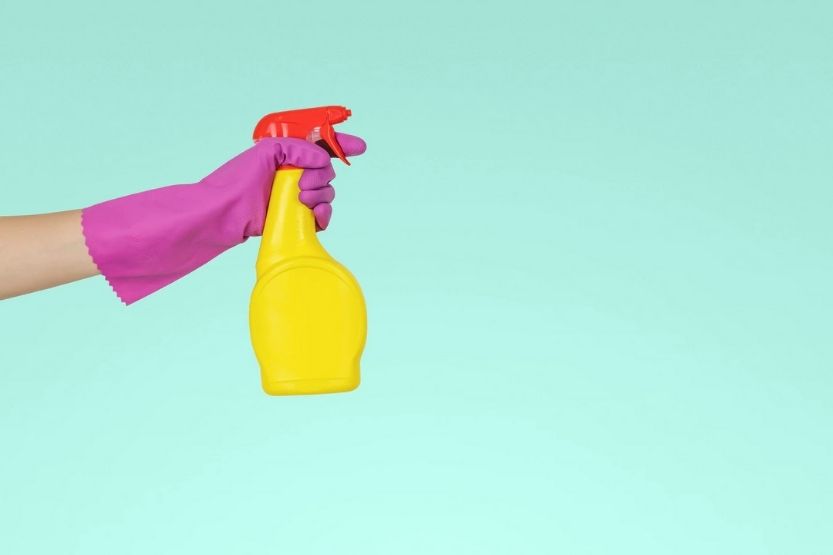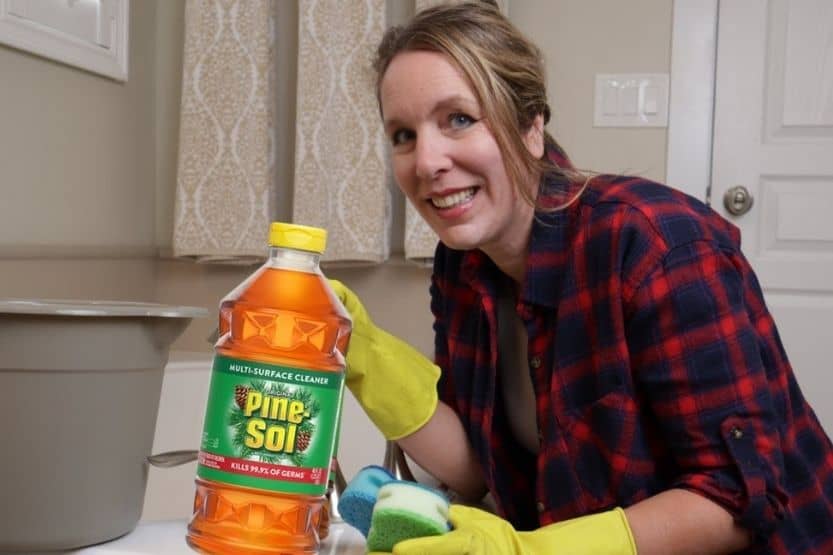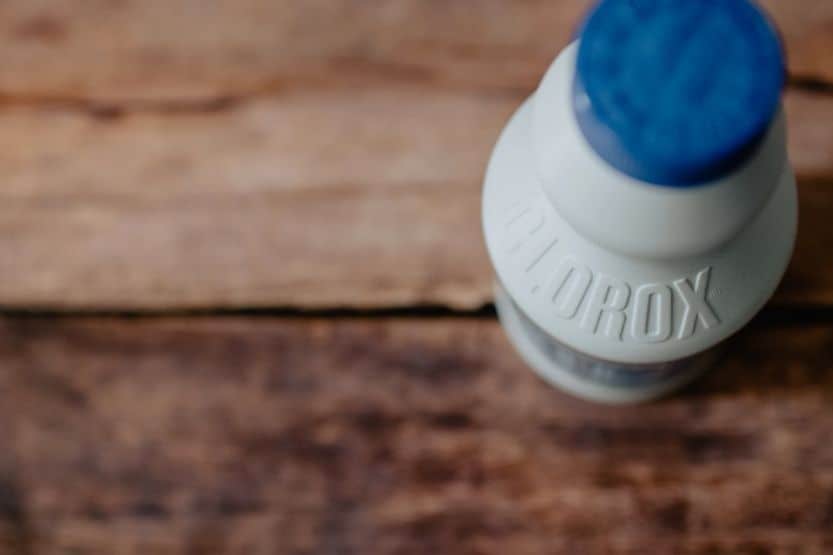Pine-Sol and bleach are two of the most common cleaners found in most households. To make a more effective cleaning solution, it is tempting to mix them. Is this safe? Can you mix Pine-Sol and bleach?
You should never mix Pine-Sol and bleach. Mixing these two substances will create toxic chlorine gas. When inhaled in large amounts, this chlorine gas could cause intoxication, respiratory arrest and even render you unconscious. Nevertheless, ingesting or inhaling a small amount of Pine-Sol will not kill you. At the most, it could irritate your throat, eyes, or skin.
The Association of Residential Cleaning Services International (ARCSI) named substances that you should never mix with bleach, and they mentioned Pine-Sol.
Read on to learn more about the other adverse side effects of mixing Pine-Sol and bleach, including other chemicals that you should never mix with bleach.
Pine-Sol and Bleach [Can You Mix Them?]

The Association of Residential Cleaning Services, International (ARCSI) has named Pine-Sol as one of the substances you should never mix with bleach. [1]
Mixing bleach and Pine-Sol will produce toxic chlorine gas that can cause the following:
- Intoxication,
- Cause respiratory arrest,
- Syncope,
- May even cause death when inhaled in large amounts, and
- Irritate your eyes, skin, and throat.
What Is Pine-Sol?
Pine-Sol is a household cleaning product originally based on pine oil. It is used to clean heavy soil stains and grease. It became popular in the 1950s.
The original Pine-Sol cleaner contains 3-7% alkyl alcohol ethoxylates, 8-12% pine oil, 1-5% isopropanol, and 1-5% sodium petroleum sulfonate. You may want to know all the ingredients of the various Pine-Sol products from its website. [2]
The Clorox Company added glycolic acid and removed pine oil from Pine-Sol in 2013. In 2014, the company eliminated the pine oil content of Pine-Sol and announced that future products would no longer contain pine oil.
Nevertheless, they offered a product containing 8.75% pine oil only for online buyers and not for physical stores. [3]
Specific Actions of Pine-Sol Cleaner
1. Multi-Surface Disinfectant
Health Canada has approved Pine-Sol as a disinfectant. Full-strength Pine-Sol can kill 99.9% of viruses, bacteria, and germs on hard non-porous surfaces.
Reportedly, it is useful in disinfecting your surrounding against COVID-19. However, there are no empirical data to prove this claim. Examples of the microbes that Pine-Sol can kill are:
- Hongkong strain of the influenza virus
- Salmonella enterica
- Pseudomonas aeruginosa
- Staphylococcus aureus [4]
2. Removes Heavy Soils and Grease
You can remove grease or heavy soils from your laundry before washing. Note that you can only use it on whites or colorfast clothes. Discoloration could occur when you use Pine-Sol with non-color-fast clothing.
3. Acts as a Deodorizer
You could use it as a deodorizer in your laundry by adding ½ cup to your wash load. You can also deodorize surface areas by using Pine-Sol to clean the surface.
Not all Pine-Sol products are suitable as clothing deodorizers, though. Hence, read the product’s instructions first before using it.
4. Toilet Bowl Cleaner
Pour ¼ cup of Pine-Sol into your toilet bowl and let it stay for a few minutes. Afterward, brush the bowl thoroughly until clean. Brush the bowl’s rim and edges to ascertain a microbe-free and clean toilet bowl.
You can also proceed to clean the toilet tiles and floor with Pine-Sol so that you can have a sparkling clean bathroom and toilet at one go.
5. Multi-Surface Cleaner
Moreover, you could clean multiple surfaces, such as floors, bathtubs, toilet tiles, sinks, diaper pails, garbage cans, and other hard surfaces. Do not soak wood surfaces but wipe off the liquid immediately.
Avoid cleaning damaged and old wood surfaces with Pine-Sol. You could exacerbate the damage. Use mild detergent and water instead.
How to Use Pine-Sol Cleaner
Mix ¼ cup of Pine-Sol for every gallon of water. You could use full-strength Pine-Sol for hard-to-remove dirt, stains, or grease.
For the Pine-Sol squirt-N-mop product, you can squirt it directly on the surface and mop it clean with a rag.

Where Not to Use Pine-Sol
Do not use Pine-Sol on unsealed, waxed, oiled, unpainted, or worn wood surfaces. Furthermore, you should use it on aluminum, copper, or marble products.
Furthermore, you should not use it as a cleaner for your car, carpet, or plates or as a pet shampoo. However, you can clean your pet’s house and other areas in your household with Pine-Sol. Note that the company does not recommend the use of Pine-Sol with steam cleaners too.
Never add Pine-Sol or bleach to your dishwashing liquid. Dishwashing products are specifically made for kitchenware. Adding another cleaner may trigger Pine-Sol’s reaction with the dishwashing liquid’s ingredients or the kitchenware’s components.
What Is Bleach?
Bleach often refers to a dilute solution of sodium hypochlorite (5-9%) that could remove color and stains from a fiber or fabric. Bleach could also refer to any chemical product that has the same action.
Specific Uses of Bleach
- Removes stains or colors from clothing
- Disinfects surfaces
- It gets rid of stubborn dirt and grime
- Whitens, sink, toilet bowls, and bathtubs
- Cleans most surface areas
Can you mix Pine-Sol and bleach? You cannot mix these two chemicals in large amounts due to the production of harmful chlorine gas. This gas is toxic and could cause fatal side effects.
Even though a case report published in the Journal of Analytical Toxicology stated that death from Pine-Sol is rare, there is still a possibility of death. You should avoid mixing any cleaning products as the gas produced is harmful to your health.
Which Is More Effective, Bleach or Pine-Sol?
Both are effective cleaning solutions in getting rid of microbes and dirt. They are also effective as bleaching solutions.
The common household bleach (5-9% hypochlorite solution) is cheaper than most Pine-Sol cleaners. Thus, households that are scrimping prefer bleach to Pine-Sol.
One advantage of Pine-Sol is that the Clorox Company offers various Pine-Sol products that you can use for other purposes. On the other hand, bleach only comes in varying concentrations.
Additionally, some users find bleach safer as a cleaner and anti-bacterial agent than Pine-Sol. But if you find Pine-Sol more effective for you, feel free to choose it over bleach. Your preferences and purpose matter the most.
Avoid Mixing These Cleaning Products
1. Bleach and Pine-Sol
As stated earlier, avoid mixing these two solutions as they react and form chlorine, which is toxic to your eyes, lungs, and respiratory system. Large amounts of inhalation or ingestion could even kill you. You may lose consciousness and then inhale more gas that could result in fatal consequences.
You can only mix Pine-Sol and bleach with water. Water does not contain any harmful chemicals that could react with both cleaning solutions.
Dilute concentrations of Pine-Sol and bleach can cause the following issues:
- Irritation of the eyes
- Skin irritation
- Irritation of the respiratory passages
Full concentrations of Pine-Sol and bleach can cause the following issues:
- Syncope or fainting
- Respiratory failure
- Death
2. Two Different Drain Cleaners
Use only one type of drain cleaner. Combining two different drain cleaners is like mixing two bombs that could react and explode inside your plumbing system.
You can experiment and find the most effective product for you and then stick to it. You may not find the right product if you keep changing your cleaner. Try each product for a week, and then decide which one works for you best.
3. Vinegar and Bleach

The combination of vinegar and bleach has the same reaction as the mixture of Pine-Sol and bleach. They produce chlorine gas that is harmful to your eyes, skin, and respiratory system.
Bleach alone can do the job for you if you use it properly. Do away with vinegar and save some money.
4. Vinegar and Hydrogen Peroxide
The combination of vinegar and hydrogen peroxide will produce peracetic acid, an eye, skin, and lung irritant. Nonetheless, you can use them separately as both are excellent cleaning solutions.
You will have to rinse the area with water first before using the second solution. This step prevents interaction between the two solutions.
5. Ammonia and Bleach
You cannot combine these two products because they react with each other and form chloramine gas. This gas has similar effects as chlorine, such as eye, skin, and lung irritation. The gas could also cause chest pain and dyspnea (shortness of breath.) [5]
You must never mix bleach and Pine-Sol. When you mix these two substances, they will react and form chlorine gas. Chlorine is harmful to your eyes, skin, and lungs in small concentrations. When inhaled in large amounts, the gas could make you unconscious, cause respiratory arrest, and even death.
Precautions When Using Pine-Sol
1. Use Appropriate Protective Gear
Protect yourself by using suitable gear, such as gloves and eye protection. Also, you may want to wear protective clothing over your skin. Be careful not to wet your clothing, as this would allow the Pine-Sol solution to seep through it.
2. Avoid Prolonged Contact with Pine-Sol
Diluted Pine-Sol solution is not as irritating as full-strength Pine-Sol. But be careful anyway. Avoid prolonged contact with the cleaner in any area of your body.
They are meant for hard non-porous surfaces and not for your delicate skin. If you accidentally have prolonged contact, wash that area using running water. Rinse off all traces of the cleaner thoroughly. Apply soap and rub off the cleaner and then wash with a profuse amount of water.
3. Ventilate Your Working Area Adequately
Ensure that the area is well-ventilated to avoid suffocation and inhalation of the cleaner. After cleaning, leave the room for a while to allow the gas to evaporate and for air to circulate.
Do not clean inside closed rooms or poorly ventilated areas. Open your windows to allow adequate air circulation when cleaning.
4. You Can Recycle the Pine-Sol Cleaning Bottle
The cleaning bottle is recyclable. Hence, you can recycle it without any problems. Do not transfer Pine-Sol solutions to other containers, though. A different container may not be durable and tough enough for your Pine-Sol solution.
5. Do Not Use the Pine-Sol Cleaner after Its Expiry Date
Typically, the Pine-Sol cleaner’s shelf-life is two years. The expired cleaner may still work, but it could endanger your health. Expired products could produce toxic substances as a result of chemical breakdown. Hence, you have to play safe and get rid of expired cleaning solutions.
6. Use Pine-Sol Only with Whites or Color-Fast Fabrics
You can test a tiny area of the fabric if you are not sure whether it is color-fast or not. It is better to play safe than damage the entire cloth. Note that Pine-Sol also acts as a bleaching agent.
7. Never Mix Pine-Sol with Other Products
Again, never combine Pine-Sol with bleach or any other products. Toxic chemicals could form and harm you. You could use each separately but only after eliminating any traces of the first cleaner.
Conclusion – Can You Mix Bleach and Pine-Sol?
You should never mix Pine-Sol and bleach. Combing them will produce chlorine gas that is harmful to your health. Inhaling large amounts of this gas has unhealthy side effects, such as syncope (fainting), respiratory arrest, and even possible death.
The Association of Residential Cleaning Services, International (ARCSI) named bleach and Pine-Sol as two of the chemicals you should never mix.
Being aware of the danger of combining cleaners and bleach will help you stay safe and healthy.
To help you remember the precautions when using Pine-Sol and bleach, here is a summary:
- Use appropriate protective gear
- Avoid prolonged contact with Pine-Sol
- Ventilate your working area adequately
- You can recycle the Pine-Sol cleaning bottle
- Do not use the Pine-Sol after its expiry date
- Use Pine-Sol only with whites or color-fast fabrics
- Never mix Pine-Sol with other products
You can use the same precautions with your bleach products.
Related reading:
Tiny White Bugs In Kitchen – What Are They and How to Get Rid of Them
Tiny Ants in the Kitchen: How to Get Rid of Them
Tiny Gray Bugs – What Are They and How to Get Rid of Them?

![Read more about the article Kerosene Heater for Garage [Tips and Best Heaters]](https://homecarezen.com/wp-content/uploads/2021/10/Kerosene-Heater-for-Garage-300x200.jpg)
![Read more about the article Kerosene Heater for Garage [Best Picks and Tips]](https://homecarezen.com/wp-content/uploads/2021/11/kerosene-heater-for-garage-300x200.jpg)
